How to Choose a Sleeping Bag for Pacific Northwest Winter Backpacking
If you are used to camping in summer and the shoulder seasons and are wondering what type of sleeping bag you’ll need for winter use in the Cascade Mountains in Oregon and Washington State, here are some basic points to consider.
I don’t represent any brands. I haven’t received any sponsorship or free sleeping bag gear from any companies. These are my independent opinions.
Picking the Temperature Rating
The first thing you need to do is to determine the temperature rating you need. That is, before purchasing a sleeping bag, you want to determine what temperature rating you need for the conditions and months you plan to be outdoors.
Winters in the Pacific Northwest are mild compared to other regions this far north. One way to determine likely temperatures is to study the average temperatures at different elevations on major peaks throughout the Cascade range. For me, the best potential campsites will start around 3000 ft, but in most instances, I end up camping around 4500–7500ft. I’ve only camped twice at higher elevations (Camp Muir at 10,000ft and Mount Adams at 12,ooo ft). Here in Washington State, if you look at temperatures on peaks North and South, West and East, you find that temperatures tend to be colder on the Eastside, as well as further North.
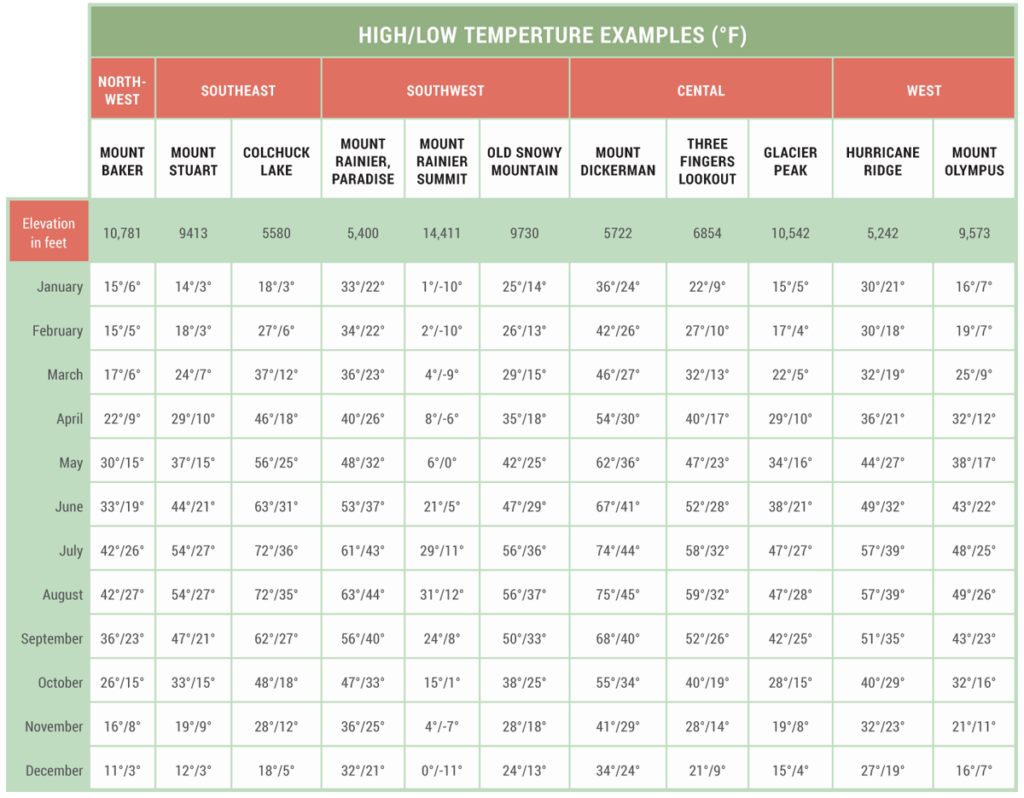
For planning purposes, I have formulated four typical scenarios:
- Shoulder season averages: 25º to 45º F (September–November/March–June)
- Winter averages: 25º F to 35º F (November–March)
- Winter coldest averages: 10º to 25º F (September–June)
- Winter deep cold averages (rare): –0º F to 10º F (occurring mostly December–May)
Notice, that 0º F weather is rare. It is so rare, I have never recorded it on any of my trips.
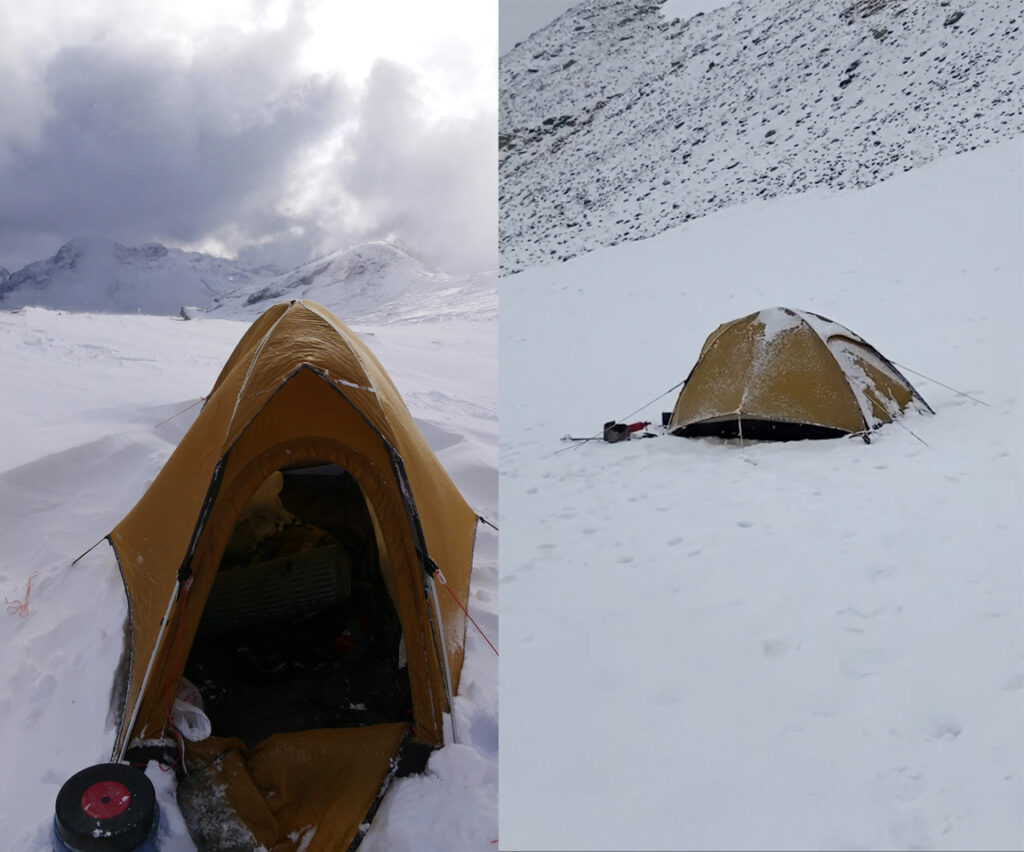
Based on this data, a 0º F (lower limit) sleeping bag will be sufficient for most trips throughout the Pacific Northwest winter season. A sleeping bag rated with a lower limit of zero degrees will likely have a comfort rating of around 15º F.
I don’t often use a thermometer, but the coldest thermometer temperature I have ever recorded is 6º F while camping on a frozen lake on the East side of the Cascade Mountains at about 5000 ft (March, end of winter). Because the expected temperature was going to be close to zero, I took a –20º F expedition sleeping bag, which allowed me to sleep comfortably with no concerns.
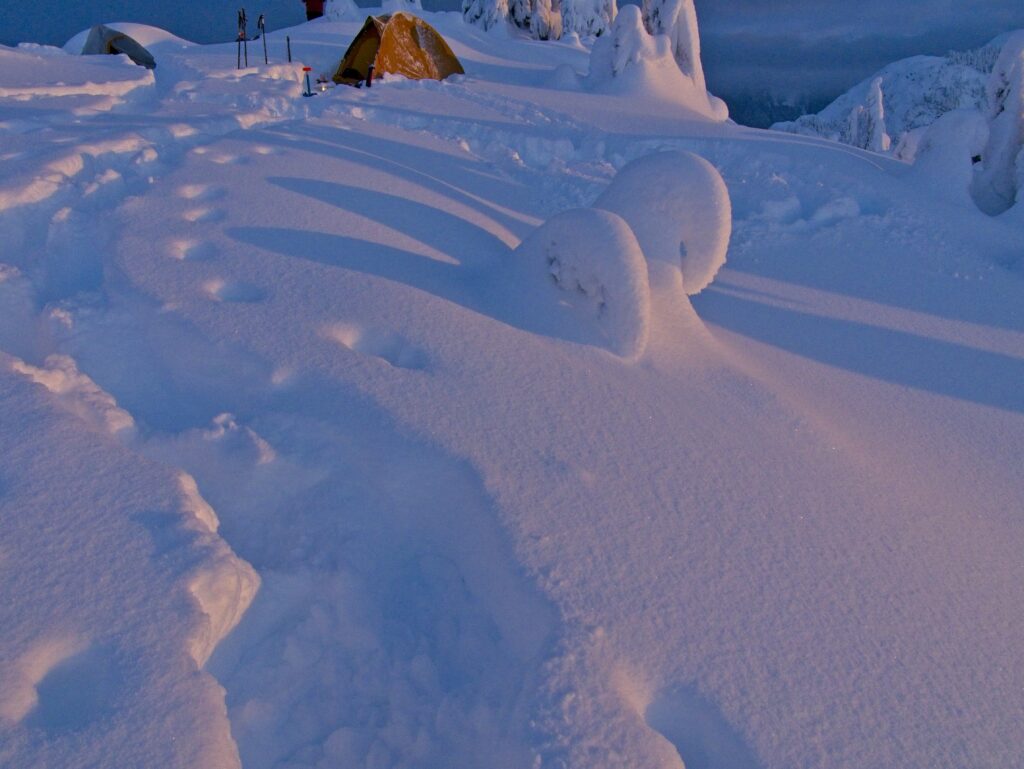
The Zero Degree Option
If you can only budget for one winter sleeping bag, get the 0º F option.
In the shoulder seasons (spring to early summer/late summer to fall) a 15º F sleeping bag will usually be sufficient. For rare deep cold winter nights, an “expedition” level (–15º or –20º F) sleeping bag will keep you comfortable. Most of the time, a 0º degree sleeping bag will be the most comfortable choice.
If you are fully committed to winter backpacking and only want to carry the minimum weight each trip requires, then you’ll want three sleeping bags, a 15º, a 0º, and an expedition-level bag ( –20º F or lower). With this range, you will be covered for almost every possible scenario, and never need to carry more weight than circumstances require.
Understandably, many people are not willing to budget for 3 sleeping bags. Another strategy is to add a sleeping bag liner to an existing shoulder-season sleeping bag.
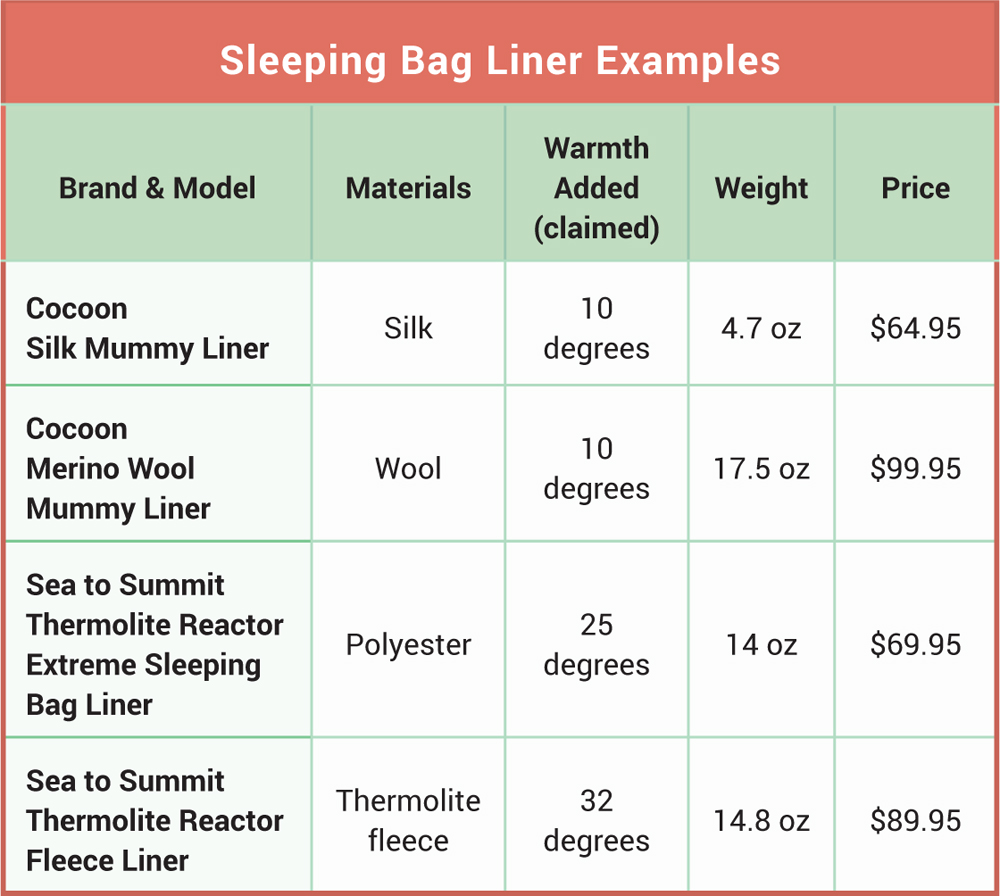
If you are a cold sleeper, which is certainly the case for me, then I recommend the 10–15 degree rule. That is, always have a sleeping bag or sleeping system that is rated 10–15 degrees warmer than the expected forecast. If the forecast is 15º F, then a 0º (lower limit) sleeping bag is the best option. If you have a 0º bag, there are very few times when a trip will have an expected lower limit beyond your gear capabilities.
Or, if the forecast is 15º F, then a 15º (lower limit) sleeping bag with a liner that adds at least 10º would work.
Extra warmth is important to me because I sleep cold. I took my zero-degree Thermarest sleeping bag on a recent trip with a forecast of 15º F, my thermometer recorded 9º F just before sunrise, and I was comfortable. Temperatures don’t always match the forecast, so the 10–15º rule is a good safety measure.
In my view, if you have to do jumping jacks to get warm while snow camping, you have the wrong gear. Certainly, if you had an accident and couldn’t easily move, you need gear that keeps you warm while you are in place during the rescue.
Regardless of the sleeping bag you have, always check the mountain forecast carefully. Freakish lows are extremely unusual but they can occur. Back on 30 December 1968, Mazama and Winthrop recorded –48°F.
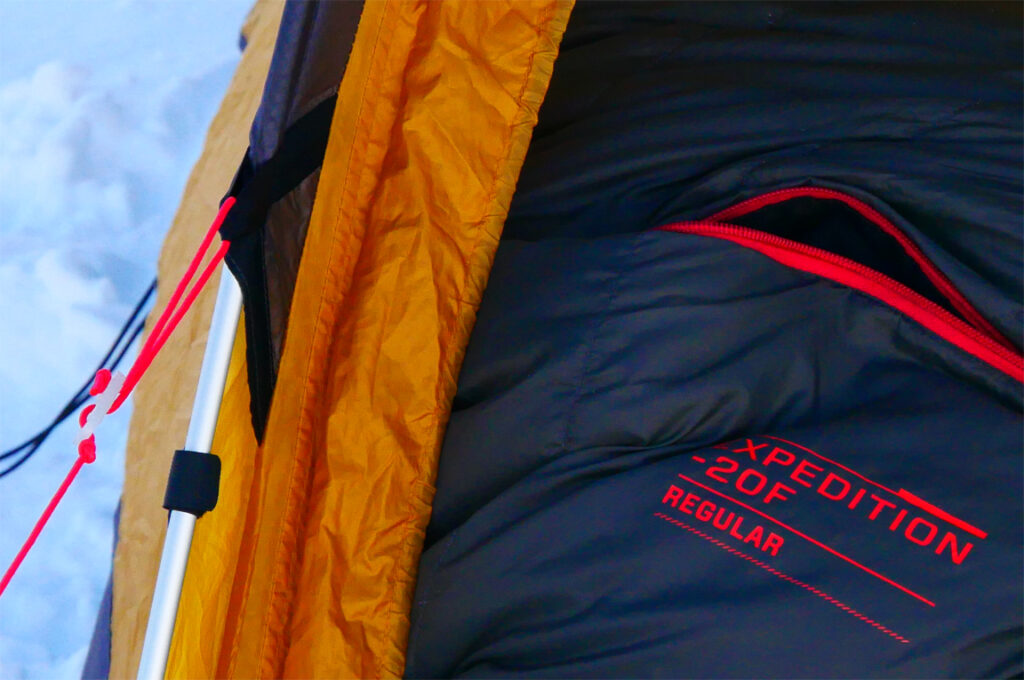
Your Body Type and Your Methods Make a Difference
On the same trip, three different hikers might use sleeping bags with three different ratings. For example, the forecast is for a nighttime low of 12ºF. In reality, the actual ambient temperature drops to 6ºF because the camp is on a frozen lake.
The first person brings a 15º F lower limit sleeping bag. The comfort rating is 25º. The 3-season tent fly extends to the ground and the door is closed which adds about 10 degrees. This person uses a hot water bottle which they reheat again (hot water bottle needs reheating for a full night). They wear midweight wool thermal clothing and an outer insulated coat. They have a body type that sleeps warm. They get by okay. They might also add a sleeping bag liner.
The second person has a 0ºF bag with a comfort rating of 10º. They have a body type that sleeps warm. They use a 3-season tent with a fly that extends to the ground and a hot water bottle with no reheating, wear nylon thermals and also close up their tent. They are comfortable.
The third person brings a –20º Expedition bag with a comfort rating of –10º and a 4-season tent. They use a hot water bottle only for half the night and wear thin nylon thermals. This person’s body type sleeps cold and they prefer to leave the tent door open at night. At 6ºF they are warm and comfortable.
If the first two of these hikers are using a 3-season tent without a snow wall and there are 10–15 mph gusts of wind, then they are cold and uncomfortable, especially the first hiker. The 3rd hiker is fine.
How Sleeping Bags are Rated
Down insulation is rated based on the number of cubic inches of loft one ounce of down produces. The loft is the primary way down captures and holds the warmth generated by your body. Down doesn’t generate warmth, it merely helps preserve the warmth your body generates. Most sleeping bags use 550–900 fill power ratings. 550 provides the lowest thermal performance and 900 the highest. But you must look at other factors too, such as how much down is used, how the bag is designed (baffle construction and draft tubes), and overall fabric quality.
Lower Limit vs. Comfort
Sleeping bags have two ratings, the “lower limit” and the “comfort” rating. Manufacturers usually, but not always, feature the lower rating in the name of the sleeping bag. I always focus on the comfort rating when trip planning because I am a cold sleeper.
- If the sleeping bag is listed as a 30º F sleeping bag, then the comfort rating is likely to only be around 40 to 45º F.
- If the weather forecast is 30º F at the planned elevation, then a 15º F lower limit rating is required for comfort.
- If the weather forecast is 15º F at the planned elevation, then a 0º F is required for comfort.
- If the weather forecast is 5º–0º F at the camp elevation, then a –20º F expedition sleeping bag is required.
Bear in mind that once the forecast gets near 0º F it is wise to overcompensate. The forecast can easily be off by 10º and the lower the temperatures go the more important it is that you have gear that will keep you comfortable and secure.
My own rule is to carry a sleeping bag that is rated 10º to 15º degrees below the forecast. This, however, is not a rule that fits everyone.
0º F Down Sleeping Bag Examples
Zero-degree sleeping bags are the optimum bags for Pacific Northwest winters, so I will focus on some of the leading examples with that rating. The table below shows only 0ºF rated duck and goose down sleeping bags. Notice that the higher-rated down is lighter but more expensive. To simplify, all bags are the men’s or unisex version and in the regular size.
Some bags are available in long sizes and the Mountain Equipment Glacier 1000 model and the Sierra Designs bags are available in a women’s version. There are not many companies that offer zero and expedition-level sleeping bags tailored specifically for women.
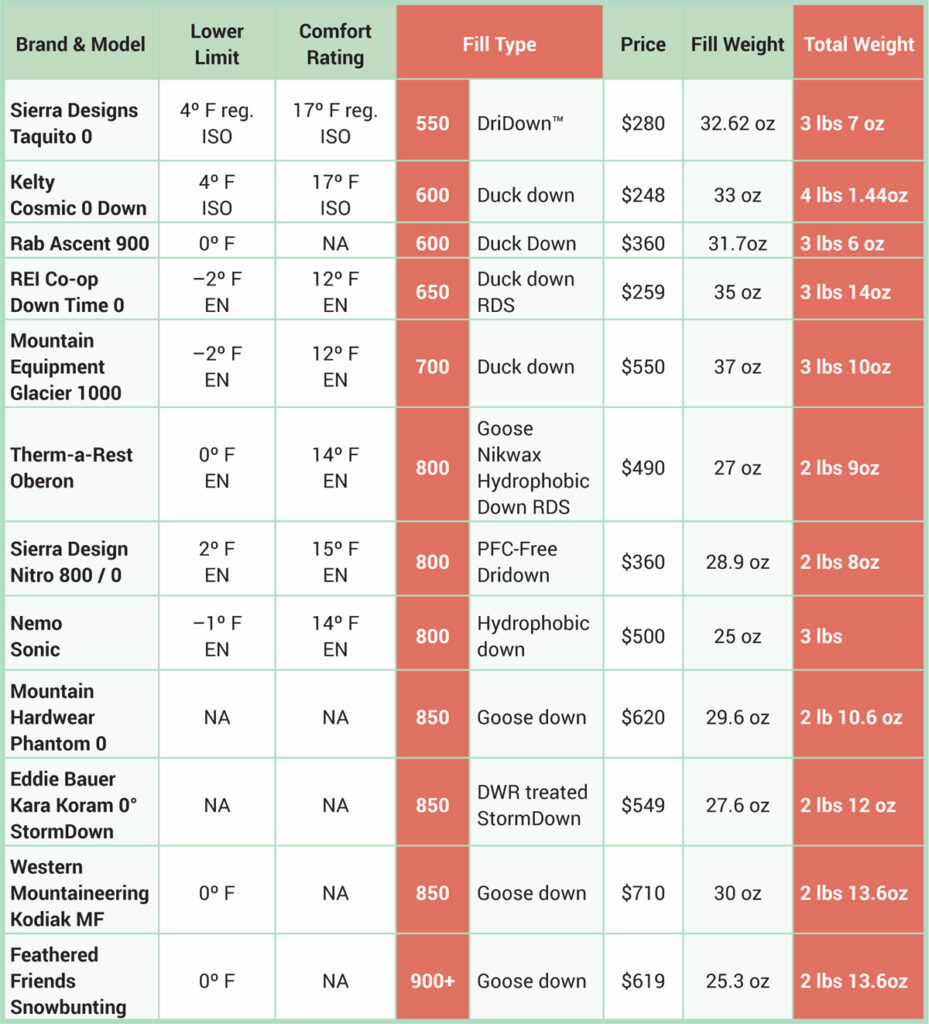
Links to Sleeping Bags in Table
- Sierra Designs Taquito 0 (No longer available)
- Kelty Cosmic 0 Down
- Rab Ascent 900
- REI Co-op Down Time 0
- Mountain Equipment Glacier 1000
- Oberon™ 0F/-18C Sleeping Bag (replaced by Parsec™ 0F/-18C Sleeping Bag)
- Sierra Design Nitro 800 / 0
- Nemo Sonic
- Mountain Hardwear Phantom 0
- Eddie Bauer Kara Koram 0° StormDown
- Western Mountaineering Kodiak MF
- Feathered Friends Snowbunting
Best Low-cost Down Sleeping Bag Options
The lowest-priced sleeping bags are synthetic. But if you are on a budget and want a low-cost down sleeping bag, the Sierra Designs Nitro (available in a women’s version) and the Therm-a-rest Oberon have good warm-to-weight ratios. Both are in the lower price range ($360–490), use 27–29 ounces of 800-power down, and ultra-light materials.
More expensive sleeping bags, such as those made by Western Mountaineering and Feathered Friends use higher fill power and put slightly more focus on durability rather than the most ultra-light materials.
A company called Hyke and Byke (not included in the table above) offers several zero-degree down sleeping bags in the $170–230 range. I know one backpacker who uses one of these and he seems content with it. Is the down responsibly sourced and it is a quality product? I don’t know. The actual down fill amounts are not posted and there is no independent rating or certifications.
Down vs Synthetic
The alternative to down is synthetic. Synthetic filling is less effective at capturing warmth than down. It is also bulkier, making it harder to pack, and it doesn’t retain loft for as long. Despite these disadvantages, synthetic sleeping bags have two important advantages:
- First, they provide more loft and warmth when they become wet from rain or tent condensation, and
- second, they are much more affordable.
The table below shows two synthetic 0º F sleeping bags compared with an equivalent down version. Notice the weight and price difference.
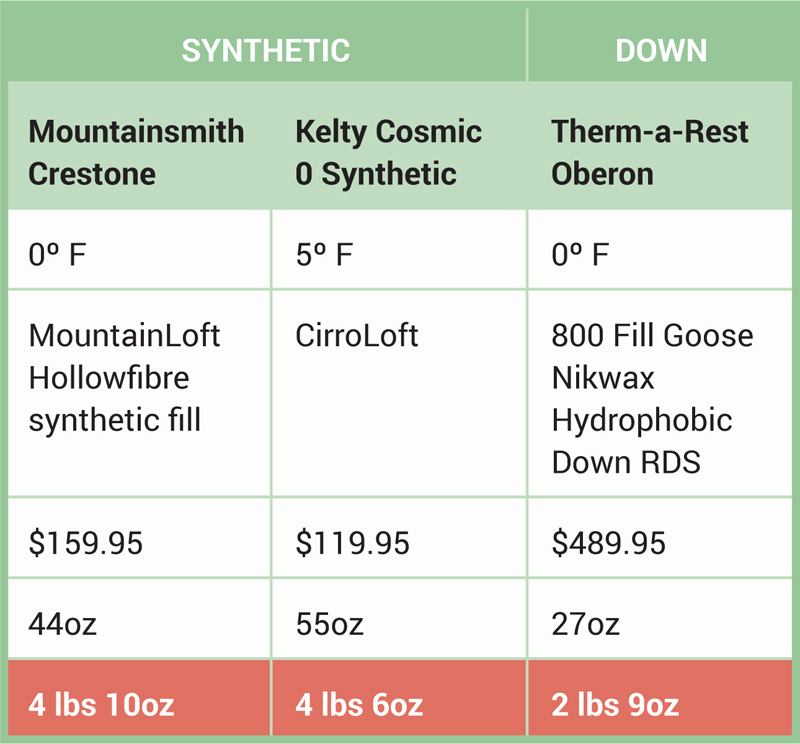
If you are on a limited budget or are unsure if winter backpacking is something you will enjoy, a synthetic 0º F bag might be a good option to consider. It’s how I got started!
Quite often in the Pacific Northwest, temperatures are slightly above freezing, making condensation a problem for down sleeping bags.
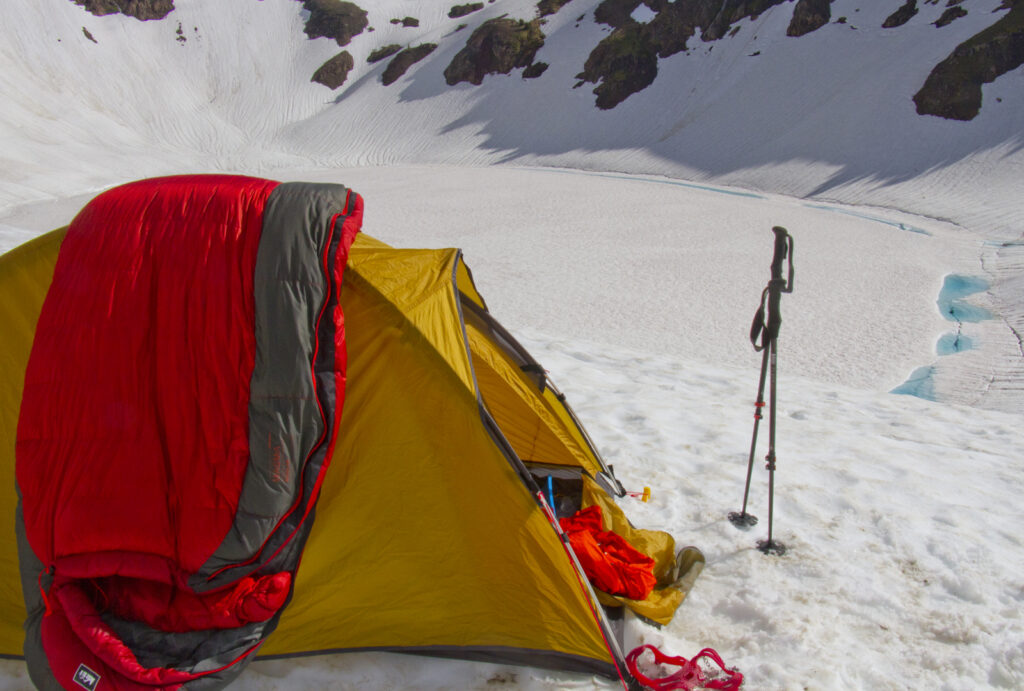
Even if it is 20–25º F, temperatures inside a tent may be above freezing. In such conditions, a 0º or 15º F synthetic sleeping bag could be more effective than a down bag on multiple night trips, especially in the shoulder season.
Packability
Synthetic sleeping bags are much bulkier than down bags when compressed. This photo provides a comparison. You may need a larger pack if you use a zero-degree synthetic sleeping bag, increasing your weight even further.
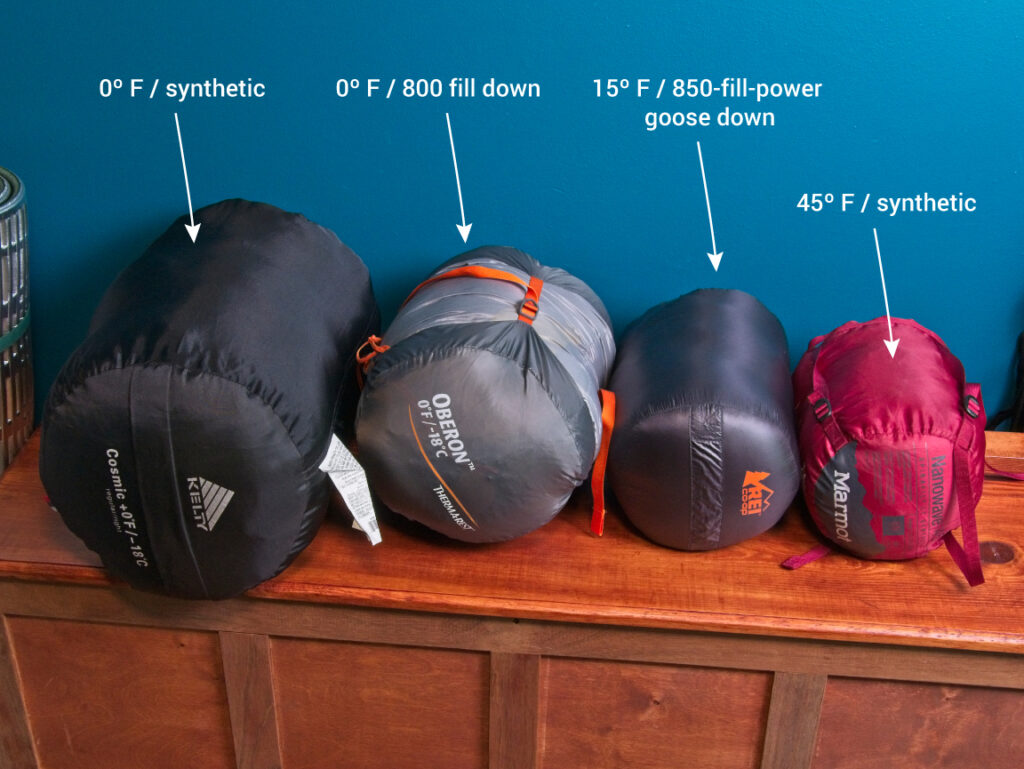
How Ratings are Determined
Some sleeping bag ratings are merely manufacturers’ claims. The first REI 0º sleeping bag I bought was shortly after reclassified as a 10º sleeping bag, before being discontinued. Nowadays, most major manufacturers have their sleeping bags rated independently using the European Norm (EN) 13537 and/or the International Organization for Standardization (ISO) 23537 testing methods. These protocols rate each bag for Comfort and Lower Limit. The Comfort rating refers to the lowest temperature the average “cold sleeper” will be comfortable, and the Lower Limit rating refers to the lowest temperature the average “warm sleeper” will be comfortable. This rating assumes the person is wearing an underwear base layer (top and bottom and a beanie) with a 1-inch thick insulating pad underneath the sleeping bag.
Some brands use the Comfort rating for women’s bags and the Lower rating for men’s and unisex bags when naming the bag. This means you cannot assume the lower limit rating is below the rating in the name. You must check the EN and ISO ratings instead. Also, be aware that some brands still don’t use the EN or ISO rating system. It is a useful system for comparing different brand models.
Ratings for Women vs Men
“Lower limit” and the “comfort” ratings mean different things for different people because everyone’s body and sleep comfort are not the same. It is generally assumed that men require less warmth than women, but clearly, some men require more. You must know your own requirements.
As mentioned above, some brands use the Comfort rating for women’s bags and the Lower rating for men’s and unisex bags. As an example, consider the REI “Zephyr 20 Sleeping Bag.” The women’s version is rated 22º F for comfort and the men’s version 21º F for the lower limit. Both are “Zephyr 20,” presumably meaning 20º F sleeping bags, but the men’s version has 15 ounces less insulation. Both cost the same and both are for 20º F, but the men’s version is lighter and less insulated. I would only consider the Zephyr for summer use, but I mention it here just to show an example of how a Women’s and Men’s sleeping bag compare.
Other manufacturers approach the issue differently. Mountain Equipment, for example, offers a model called the “Glacier 1000” in both women’s and men’s versions. Both have the same EN rating, but the men’s version has more rather than less insulation, and Mountain Equipment has its own “Good Night’s Sleep rating,” which is 7 degrees warmer than the men’s version, even though it contains only 2 oz more down. It is nice that Mountain Equipment has decided to create cold-weather sleeping bags for women, but before one makes much of this, note that when comparing the two bags together, there doesn’t appear to be any differences in the tailoring. Both the men’s and women’s versions have a shoulder girth of 62 inches and a hip girth of 54 inches. Color and the 2 oz difference in fill are the only things that distinguish the versions.

Sierra Designs are even more identical:
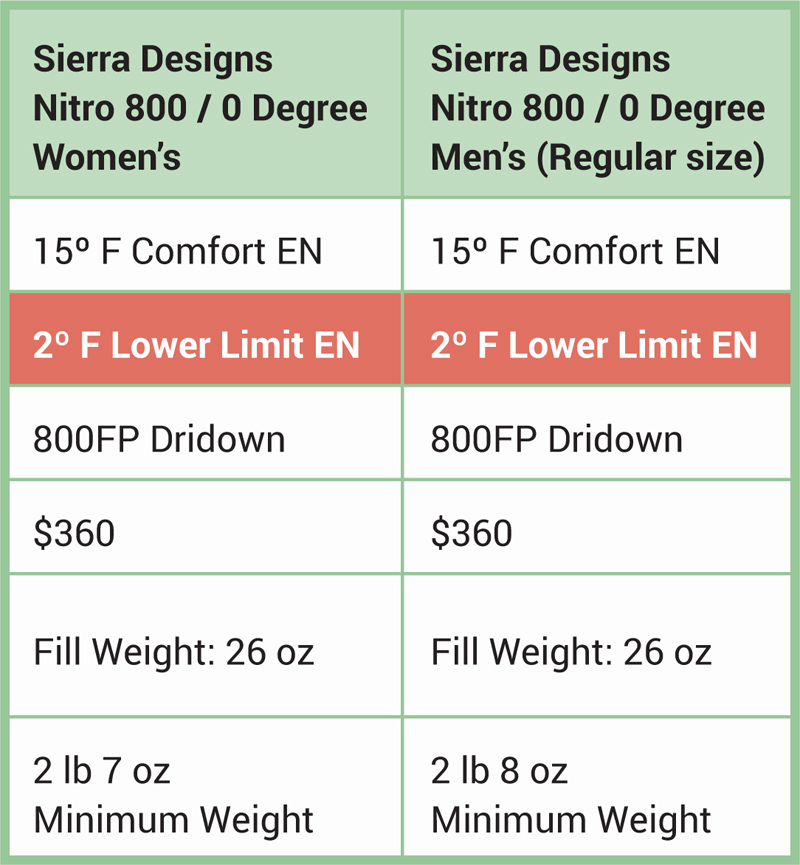
I have known men and women who say they use 0º F sleeping bags in 0º F weather and are comfortable. I’m not sure if they were accurately determining the temperatures they were experiencing, but I do know that this would not work for me. I never plan to use a sleeping bag in a situation where the lower limit matches the expected temperature. I always plan for 10–15º of extra warmth, without considering other factors such as hot water bottles, warmth captured by my tent, or additional insulated clothing.
One thing is certain, there is no consistent rule for distinguishing women’s and men’s sleeping bags. For example, the REI Co-op Zephyr 20 Sleeping Bag, there is 15 oz less down in the men’s version, but in the Mountain Equipment Glacier 1000 Sleeping Bag, there is 2 oz more. With the Sierra Designs Nitro, the specs are the same. This means it is not always the case that manufacturers make one gender more insulated than another, but rather that each manufacturer has its own approach.
When almost everything is the same, there is still somehow a slight difference in the final weight. This is likely because the women’s sleeping bag uses the same materials for a slightly shorter bag. My advice is to not concern yourself with gender labels and instead match your body and needs with the specifications that work best for you. For example, here are the three available sizes for the Sierra Designs Nitro. One of these is the women’s version.
Fits Up To: 5′ 8″ / 173 cm
Length: 74in / 188 cm
Shoulder Circumference: 58″ / 147 cm
Hip Circumference: 58″ / 147 cm
Footbox Circumference: 39″ / 99 cm
Fits Up To: 6′ 0″ / 183 cm
Length: 78in / 198 cm
Shoulder Circumference: 62″ / 157 cm
Hip Circumference: 56″ / 142 cm
Footbox Circumference: 40″ / 102 cm
Fits Up To: 6′ 6″ / 198 cm
Length: 84in / 213 cm
Shoulder Circumference: 64″ / 163 cm
Hip Circumference: 58″ / 147 cm
Footbox Circumference: 42″ / 107 cm
Does gender matter? Don’t women come in different sizes, just as there are short and tall men?! All the options use the same colors. Even if you are a woman who can fit perfectly in the woman’s option, you might want to choose the next size up for the extra space to put your boots at the bottom to keep them from freezing overnight.
Finding the Right Fit
If you can, visit a gear showroom and ask to try out the sleeping bag. REI allowed me to lay out a sleeping bag and get in so I could see how the width and length worked for me. At first, I disliked mummy bags, but with more experience I now prefer them. They are simply the most effective design for preserving body warmth and that’s the main purpose of a winter sleeping bag. That aside, you don’t want a bag that is too tight or the wrong length.
A bag that is tailored to fit your body length and shape will provide the most efficient warmth. However, having some extra space for gear such as a hot water bottle, electronics, clothing, and even boots can be beneficial. If my boots are wet from snowmelt, I bag them and put them inside the bottom of my sleeping bag on deep cold nights. This prevents the boots from freezing solid and being painful to put on the next day. If your boots are already frozen, don’t bother putting them in your sleeping bag. They will remain frozen and just keep your feet cold at night. Thaw the boots out instead with a hot water bottle in the morning.
Shoulder Season
This article is just about winter sleeping bags, but I would like to mention one shoulder season option. For warmer trips, my own go-to preference is the REI Magma 15º F, which is available in a women’s edition. This bag is 850-fill-power goose down, and for an ISO comfort rating of 28º F, it only weighs 1 lb 13 oz, which is an impressive warmth-to-weight ratio. It is around $380–400, but you can likely get one on sale. I often take the REI Magma 15 even when the forecast puts temperatures close to 50ºF because my 40º F sleeping bag is not any lighter, and I would rather have extra warmth than not enough. That is, if there is no weight saving from the cooler bag, I would rather have the extra back-up warmth.
The Total Sleeping System
Whatever sleeping bag you buy, it alone will not be enough. You have to have a complete system. For some hikers, their system will include a sleeping bag liner, extra quilt, or hot water bottle. Some strategies are optional, but the pad/mattress under the sleeping bag is essential, as is the need for wind protection. That is, you must have enough “R-value” or cold resistance under your sleeping bag.
For me, a total winter sleeping system consists of:
- An appropriately rated sleeping bag
- Two sleeping mats: One closed-cell pad and one air mattress with a combined R-value of at least 5. More is preferable (9 is achievable).
- A tent for wind protection.
- A complete dedicated head-to-toe base layer.
- A hot water bottle (highly recommended, but optional).
- Air-mattress repair patches.
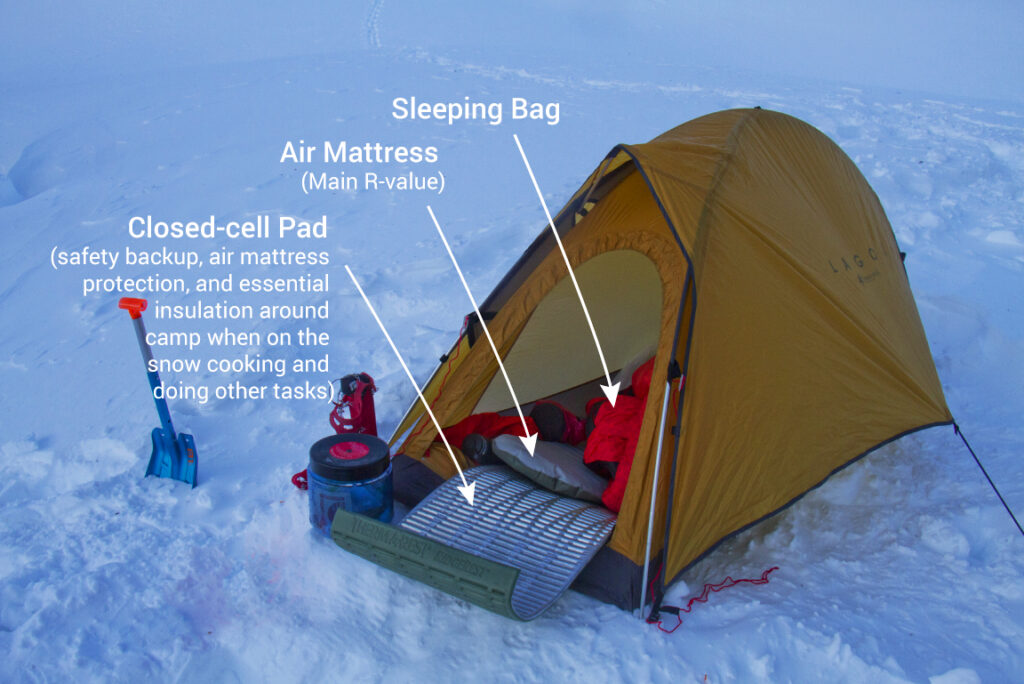
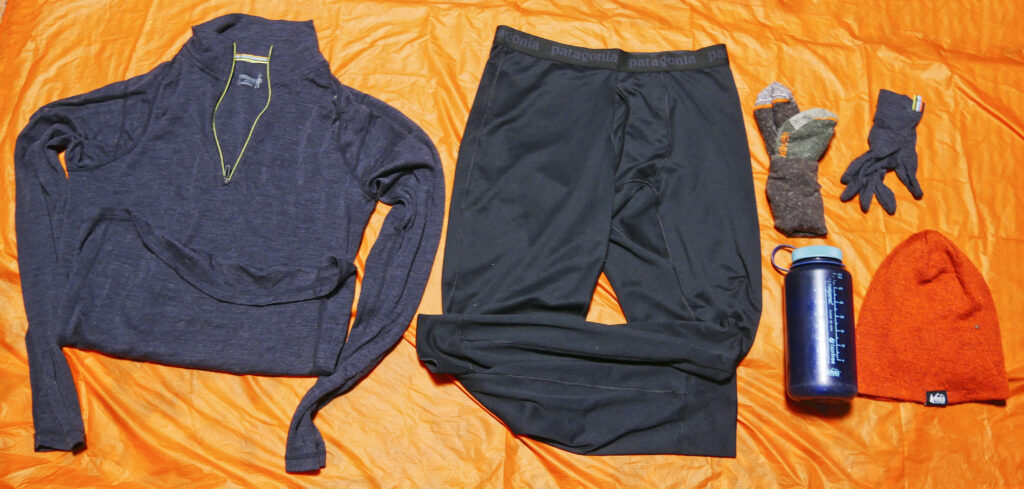
Ideally, your air mattress alone should have a 5+ R-value. The closed-cell pad is primarily for protection, backup, and use around camp. In an emergency, someone can loan their closed-cell pad, and the two closed-cell pads combined will get the person with the failed air mattress through the night.
Protect Your Air Mattress from Sharp Objects
Quite often, your pack and other gear will be partially under your air mattress. The closed-cell pad can cover this gear and will help protect the air mattress from anything sharp. However, it is important to check the gear for anything that might puncture the air mattress such as unclipped pack straps, stoves, and stove windscreens. Some items can be wrapped in your gaiters to cover the edges.
6 Tips for Maximizing Warmth
If you are shivering on a winter backpacking trip while standing around camp or in your sleeping bag at night, then you are doing something wrong. You either don’t have the right gear or you are not using it correctly.
1. Maximize Loft
Always shake out and fluff up your sleeping bag as much as possible when you set up camp. The loft helps capture your body’s warmth.
Don’t lay anything over your sleeping bag that will reduce its loft. Rather than adding warmth, it will reduce loft and that will lower the sleeping bag’s ability to capture warmth.
The foot of your sleeping bag usually has extra down to help keep your feet warm. If you are short, be sure to pull up the bag so your feet are at the bottom of the bag to benefit from the extra loft provided.
2. Seal in the Heat
The purpose of the mummy bag design is to keep the warmth close to your body, eliminating extra areas for your body to heat, and sealing off ways for the heat to escape. This means that a good-quality bag will have a baffle along the zipper to prevent warmth from escaping and a drawstring around the face. Also, if your sleeping bag has a neck baffle, make sure it is positioned correctly to prevent warmth from escaping around your neck.
For these reasons, rectangular designs and quilts are less efficient. If you decide to use a quilt, it helps if the quilt has a draft collar and working kneck snap, and add a down hood and/or beanie.
3. Keep the Tent Ventilated
Leaving the door open reduces tent condensation which is a threat to the effectiveness of your sleeping bag. Frost on your tent walls is better than liquid moisture running down your tent walls. If temperatures are above 20–25º F, you are more likely to get water around your sleeping bag with the tent door closed. Down sleeping bags lose loft when wet and become ineffective. It is important to keep your sleeping bag and clothing dry. A 4-season tent will add about 10º of warmth if the door is closed.
I keep the door open unless it is snowing or too windy. Enjoy the fresh air. If you have a sleeping system rated for the weather, you don’t need the extra warmth a tent can provide.
Your body can breathe out about a liter of water in the course of a night. Even with a double-walled 4-season tent and the door open I sometimes get condensation on the interior tent walls and on top of my sleeping bag.
4. Avoid Sweaty Clothing
To maximize warmth, always sleep in a fresh base layer. This means packing fresh socks, thermal leggings, thermal top (nylon, Capilene, or Smart Wool), and beanie for the purpose of always having a dry base layer at night. Avoid sleeping in clothes that you have hiked in during the day. Your hiking clothes may seem dry but are likely moister than you realize and that moisture wicks warmth away from your body. Also, this dedicated nighttime baselayer will help protect your sleeping bag from sweat and body grime.
5. Use a Hot Water Bottle
There are few things more enjoyable than a hot water bottle. I always carry a one-liter Nalgene bottle for this purpose. Arguably, it is not necessary. Your body will eventually warm up in the sleeping bag. However, you may not realize it if your body has lost too much warmth before sleep. A hot water bottle between the thighs and next to your main arteries will quickly restore warmth to your body and help you get a comfortable sleep.
You can also use a hot water bottle around camp inside your jacket or next to your feet.
Re-tighten the lid about 10 minutes after filling the bottle. The bottle expands from the heat and the lid loosens. Keep it tight so it doesn’t leak out at night. This can, however, make opening the bottle in the morning extremely difficult.
The ability to operate a stove in high winds, cold temperatures, and high elevations to create a hot water bottle is a first-aid skill for hypothermia. A hot water bottle stays hot for about half the night. The main purpose is to be warm right when you go to sleep.
6. Have 5+ R-Value
Your body compresses the sleeping bag under your body. This allows warmth to easily transfer to the ground. For this reason, you must have insulation under your sleeping bag or the sleeping bag will be almost useless. An effective sleeping pad strategy consists of a solid core sleeping pad (usually 2 R-Value) and an air mattress (usually 3–7 R-value). This combination provides the necessary 5+ R-value.
Take great care to store sharp items and belt clips away from your air mattress in your pack and tent.
A combination pad + mattress is a safety precaution. Air mattresses alone can have all the R-value you need, but the solid core pad is an important backup strategy. If the air mattress fails, someone else can lend you their pad so that the two pads together can get you safely through the night.
Sleeping bag storage
Always store your sleeping bag in a hanging position or large breathable storage sack to help retain the bag’s loft. Never leave a bag compressed for long periods because this will damage the down or synthetic fibers.
When packing the sleeping bag in your backpack, only compress the sleeping bag as much as necessary. When you take it out to use it, fluff it up as much as possible. The effectiveness of the sleeping bag depends on its loft. Eventually, sleeping bags lose their loft and need to be replaced. Down sleeping bags last longer, maybe 10 years with weekend use, and synthetic sleeping bags last about half that amount of time.
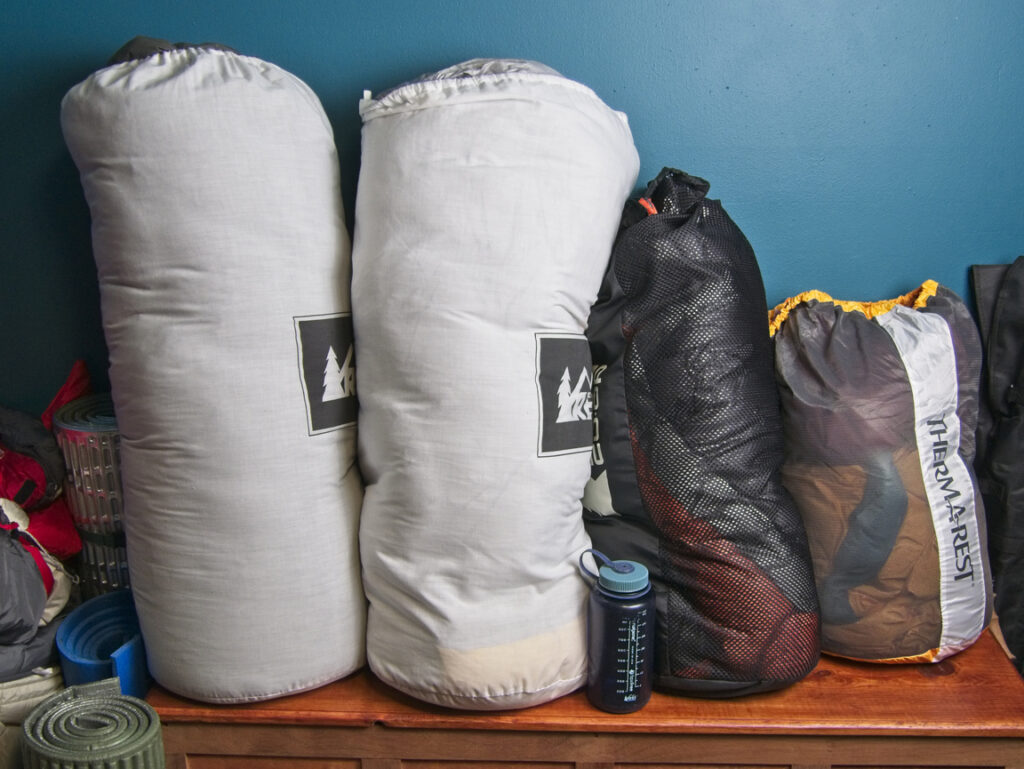
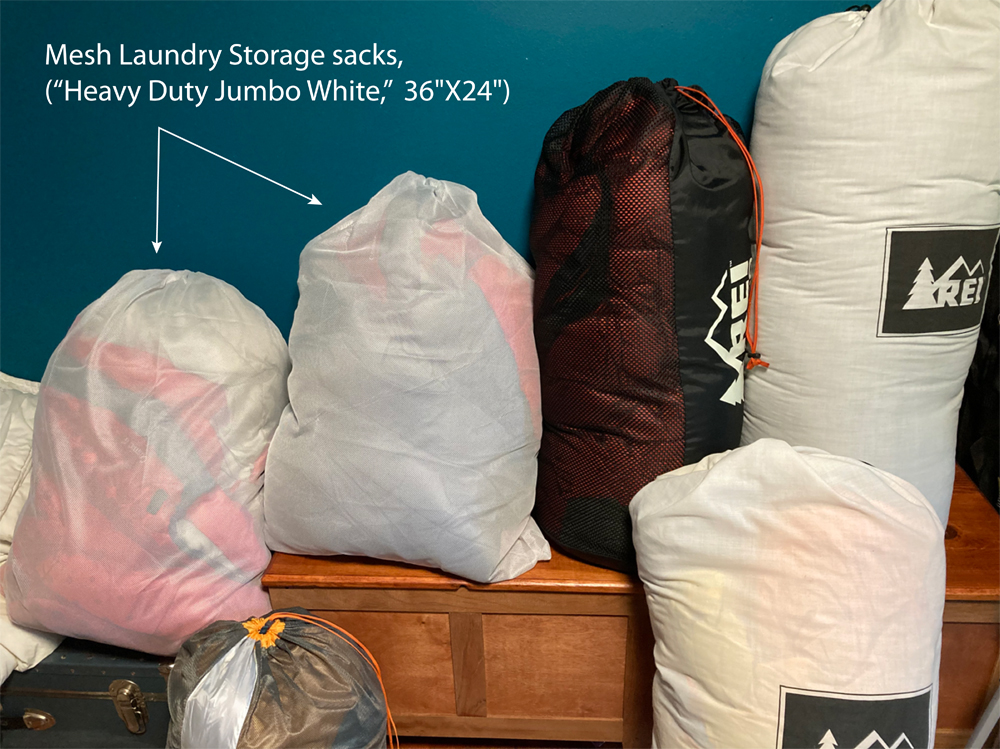
Fun Facts
So what’s the warmest sleeping bag money will buy? Feathered Friends offers the Snowy Owl EX -60º F Sleeping Bag, for $1,139. This bag is described as “the warmest sleeping bag on the planet” and “the bag of choice for polar expeditions.” Thankfully, one doesn’t have to carry this 5 lb bag here in the Pacific Northwest.
What does a deep cold weather sleeping bag weigh if it is synthetic? Browning Camping makes a “McKinley” –30º synthetic sleeping bag that weighs 12 lbs 12 oz.
If you have comments or questions, please comment below.
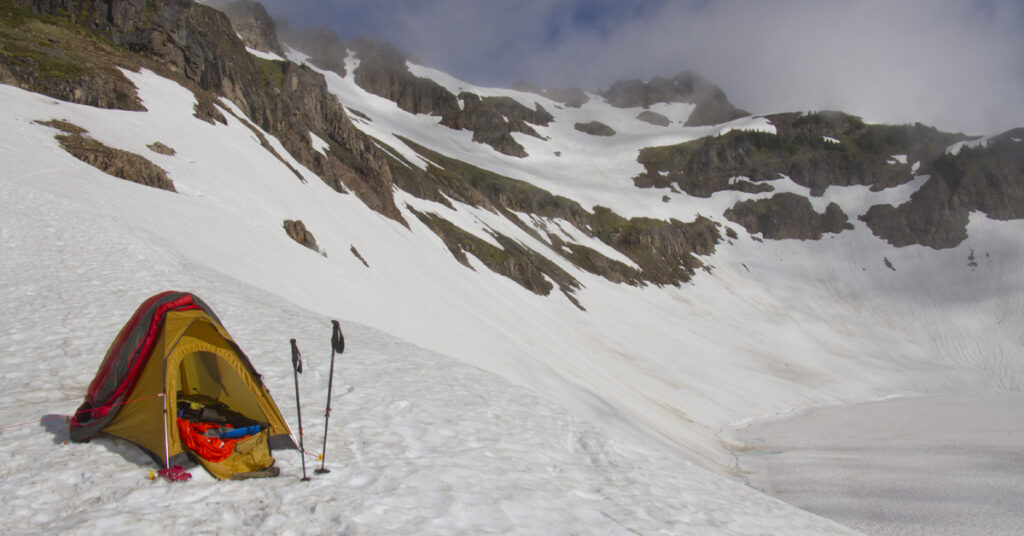
2 replies on “Winter Sleeping Bags”
Instead of cloth bags for storing sleeping bags/quilt I use plastic storage boxes. That allowes me to stack them as well as letting the bags loft a bit more. Plus, I can justify them to my wife as earthquake supplies.
Plastic boxes could work provided they have holes so the material can breath.